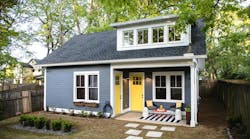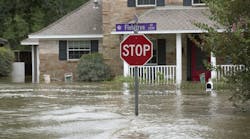Built to Last
|
Brick: It exudes warmth, character, staying power. Brick often commands a higher resale value and naturally provides thermal mass, which offers some insulation. Under normal weather conditions, it could see a century or more of use, according to Brick Industry Association estimates.
But for all its durability, brick is vulnerable to external factors that can decrease the lifespan of a brick home or addition. The greatest threat to brick is moisture. If you're building a brick addition, ensuring the quality of the structure over time depends largely on controlling moisture by choosing the right materials and installing flashing properly. If you are restoring an older home, careful inspection will determine how well the brick has weathered the test of time, and whether you need to take corrective action.
The quality of the brick, mortar, and flashing are all key factors in brick durability. When selecting brick and mortar, climate and function are important.
Dale Carstens of New Creation Masonry in Las Vegas has worked in the Midwest, West, South and Southeast. A 20-year veteran of the trade, Carstens advises, "Use a material in the place where it is designed to be used." Check the ASTM standards for appropriate recommendations. ASTM C216, "Standard Specification for Facing Brick"; ASTM C270-04, "Standard Specification for Mortar for Unit Masonry"; and other standards can be found on the ASTM Web site at www.astm.org.
Brick is a porous material and still contains some moisture after it is laid, so careful design is essential to ensuring that a brick wall can breathe. Today, brick walls are typically designed with a cavity between the exterior veneer wall and the drainage wall, and with wall ties that connect the brick veneer to the backing system. Flashing is installed inside this cavity, where water can collect — for example, at the base of the wall, the rooftop, at windowsills, and at projections or recesses. Properly installed flashing will collect penetrated water and drain it back to the exterior through weep holes. Flashing is typically required by code.
If you're restoring an older brick home, look for signs of damage. Many homeowners imagine that brick is maintenance free, so problems often go unnoticed. Check the exterior for deteriorating mortar and caulking, plant growth and water penetration. Check the interior for signs of moisture presence or damage. Corrective actions could include cleaning, re-pointing and re-caulking. Cut plants, such as ivy, as close to the surface as possible without pulling. Be sure to clean out any clogged weep holes.
A sign of water penetration can be efflorescence, a white, salty deposit on the brick surface. If it's caught early, a stiff brush may get rid of it. If not, try a brush and water, but if hard deposits have formed, it's time to look for a chemical cleaner.
But aren't chemicals too harsh for brick? Tom Mitchell, a masonry specialist with Potomac Valley Brick and Supply Company in Rockville, Md., suggests thoroughly saturating brick with clean water before applying a chemical cleaner to protect the brick from potentially harsh chemicals. After cleaning, rinse the wall with fresh water. Before using any chemical product on brick, however, check with the brick manufacturer first. Power washing is usually not recommended.
Mortar is another critical inspection point. Mortar is less durable than the masonry it binds and will eventually deteriorate. When mortar becomes soft or damaged, it can become a source of water infiltration, so it needs to be re-pointed (carefully removed and then replaced with new mortar). Match the new mortar to the existing mortar as closely as possible for uniform strength and to protect the brick from spalling, or flaking.
The age and geographic location of the building can help in identifying a comparable mortar. Mortar in historic buildings is usually softer than the mortar made today. Though somewhat costly, a sample of the old mortar can be analyzed for a close match. More information on re-pointing historic mortar can be found on the National Park Service Web site at www2.cr.nps.gov/tps/briefs/brief02.
Trey McCoy of Old Mississippi Brick Company in Holly Springs, Miss., cautions that mortar can deteriorate if exposed to a direct, constant drip or severe climate conditions. Make sure drain spouts are not draining directly onto the wall. He also notes that since modern mortar is more durable than old mortar, historic or older buildings will need to be re-pointed more frequently. PATH recommends repointing every 25 years.
How does water enter a brick wall anyway? It depends on whom you ask. Some say it enters through the mortar; others say the brick. The Brick Industry Association suggests that water usually enters between the mortar and the brick.
Regardless of how it enters, water can penetrate the wall in the form of rain, water vapor or condensation. As an extra precaution, some recommend using a chemical coating or sealant.
There are two main types of water repellents: those that form a film on the surface and those that penetrate the surface. Films repel water and usually protect the surface from graffiti and other markings. Films can even protect hairline cracks from water infiltration. Films tend to leave a glossy or darkened appearance, which may be desirable or undesirable. While they may be good at keeping water out, they are also good at keeping water in, so the brick can no longer breathe. If water is trapped in the brick and you hit a freeze-thaw cycle, the coated brick can become cloudy or spall.
Penetrants penetrate the surface and coat the brick pores, making them water repellant. Penetrants are translucent and tend to let the wall breathe more than a film. They may be useful in rainy areas, or on chimneys or parapets exposed to harsh elements. Penetrants could also be beneficial in cold, moist climates like the Northeast, East and Northwest.
For new construction, allow at least one-month curing time before applying a water repellent to the finished wall. If it is not applied completely, water can penetrate, and the water repellent will prevent it from escaping. Moisture trapped in the wall can lead to mold, dampness and poor indoor air quality. For existing structures, make any necessary repairs, carefully clean the wall, and give it ample time to dry.
Remember that water repellents are not necessarily long-term solutions. The lifespan varies greatly from product to product and can be affected by weather conditions, the amount applied, and exposure to UV rays.
If you know who manufactured the brick, ask for a sealant recommendation based on the nature of the brick. Read labels carefully to find products that will achieve the desired effect. Also check with the water repellent manufacturer for any special maintenance or application instructions.
Review past performance from a solid reference. Did the product perform successfully? Was it used on the same type of brick and mortar that you are using? Were the climate conditions the same as your own? How long did the product last? How often does it need to be reapplied, and does the old sealer need to be stripped off before reapplication? Make sure the product you choose is specifically designed for your application — interior or exterior; floors or walls; brick, stone, or concrete.
On the other hand, the Brick Industry Association asserts that water penetration can be avoided with careful materials selection, design, and detailing, as well as quality construction and proper maintenance. As Carstens puts it, "Select a good-quality brick that doesn't need anything added to it." If the work dictates that you use existing brick of questionable quality, one of the important elements of preventing water penetration may be compromised. In this situation, you may want to consider water repellents.
With either method, preventing water penetration will help maintain the appearance and integrity of a brick home for years to come.
|

